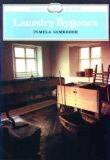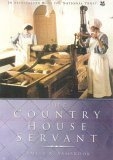-
History of:
- Resources about:
- More:
- Baby walkers
- Bakehouses
- Bed warmers
- Beer, ale mullers
- Besoms, broom-making
- Box, cabinet, and press beds
- Butter crocks, coolers
- Candle snuffers, tallow
- Clothes horses, airers
- Cooking on a peat fire
- Drying grounds
- Enamel cookware
- Fireplaces
- Irons for frills & ruffles
- Knitting sheaths, belts
- Laundry starch
- Log cabin beds
- Lye and chamber-lye
- Mangles
- Marseilles quilts
- Medieval beds
- Rag rugs
- Rushlights, dips & nips
- Straw mattresses
- Sugar cutters - nips & tongs
- Tablecloths
- Tinderboxes
- Washing bats and beetles
- Washing dollies
- List of all articles
Subscribe to RSS feed or get email updates.
Ironing is generally dispensed with, in the case of all but the garments which require to be starched, and its place will be supplied by a process of stamping, which is also accomplished by the native servants. The result is more satisfactory than might be expected; still an English housewife will be very glad to have her preferences for perfectly smooth linen indulged, as it can be, when she possesses a patent mangle.
Hints for Emigrants' Wives [in South Africa], 1859
Laundry Bygones by Pamela Sambrook, from Amazon.com or Amazon UK
Pamela Sambrook, The Country House Servant from Amazon.com
or from Amazon.UK
This book has about 100 pages on old laundry methods.
Patent box mangles
Box mangles, Baker's mangle, 19th century improvements in mangling
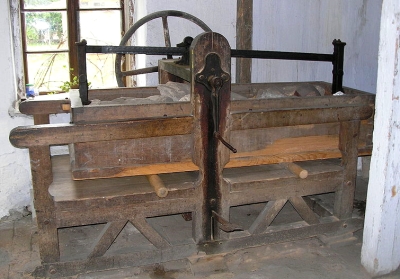 Simple box mangles were in use in
the 18th century, but they needed two people to push and pull the
heavy box back and forth with leather straps or wooden handles. The weight of a
box filled with stones, or sand, was used to press household linens and clothes
wound
on rollers below, or sometimes the linen was spread flat under the rollers.
A specially-woven mangle cloth matching the width of the box might be used
to cover the freshly-laundered things and keep them clean.
Simple box mangles were in use in
the 18th century, but they needed two people to push and pull the
heavy box back and forth with leather straps or wooden handles. The weight of a
box filled with stones, or sand, was used to press household linens and clothes
wound
on rollers below, or sometimes the linen was spread flat under the rollers.
A specially-woven mangle cloth matching the width of the box might be used
to cover the freshly-laundered things and keep them clean.
The early 19th century saw a variety of "patent mangles", all invented to lighten the work to some extent. Systems of gears, wheels, and handles were intended to make it a less tedious and tiring job.
The box mangle was itself a development from the much older custom of pressing with hand-held mangle boards: boards with a variety of names in English: bittle, batler, beetle and battledore among them. (Some of these names were also used for the washing bats used to pound dirty laundry.)
In the following description from 1838, it was clearly for smoothing (or "ironing") cloth, even though in the UK mangle later came to mean a wringer for squeezing out water.
MANGLE. A domestic machine of great utility, employed in smoothening linen, as a substitute for the heated irons extensively used for the same purpose. In the common mangle, as most of our readers well know, the linen or other articles to be mangled, are wrapped round wooden rollers, which are upon a solid level bed or floor, and upon the rollers is placed a large oblong box which is filled with stones, or other heavy substances, in order that they may press with great force upon the rollers, while the box is moved backwards and forwards upon them, by means of a handle attached to an upper roller or windlass, to which straps from each end of the moving box are attached. By this machine, the operation of mangling is very well done, but the labour is excessive on account of the necessity of frequently arresting and changing the motion of the heavy box.
The Engineer's and Mechanic's Encyclopaedia, London 1838
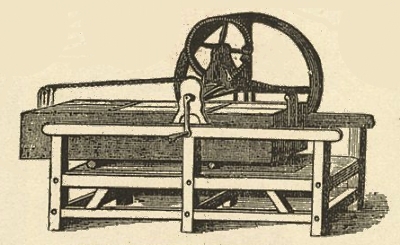 Baker's patent mangle (left) was one of the earliest and best-known machines invented to
make mangling less laborious. The writer of the Encylopaedia quoted above said "An important
improvement in the construction of the common mangle ... was effected
about thirty years ago by Mr. Baker, of Fore Street, London, by which the otherwise
unwieldy heavy box was moved with great facility backwards and forwards, by a continuous
motion of the handle in one direction; and by the addition of a fly wheel to equalize
the motion, a great amount muscular exertion is saved to the individual working
the machine."
Baker's patent mangle (left) was one of the earliest and best-known machines invented to
make mangling less laborious. The writer of the Encylopaedia quoted above said "An important
improvement in the construction of the common mangle ... was effected
about thirty years ago by Mr. Baker, of Fore Street, London, by which the otherwise
unwieldy heavy box was moved with great facility backwards and forwards, by a continuous
motion of the handle in one direction; and by the addition of a fly wheel to equalize
the motion, a great amount muscular exertion is saved to the individual working
the machine."
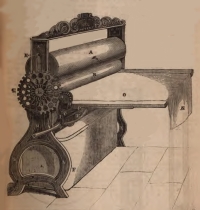 By 1823 someone in England had patented a design for a upright mangle to meet the
obvious objection to the "common horizontal mangle": "namely, the great space they
occupy". Soon the distinction between mangling as smoothing, and mangling as wringing,
became blurred, since very similar machines were suitable for both purposes. Barnard
and Joy's "patent self-rolling mangle" from the 1830s was still intended for "ironing";
the bottom roller has an attached mangle cloth which would help keep the newly-pressed
fabric clean and smooth. The Mechanics' Magazine of 1838 explained that
the "weighted rollers" replaced the "cumbrous travelling bed" of the familiar box
mangles. Patent mangle became the British
name for all sorts of Victorian
mechanical mangles.
By 1823 someone in England had patented a design for a upright mangle to meet the
obvious objection to the "common horizontal mangle": "namely, the great space they
occupy". Soon the distinction between mangling as smoothing, and mangling as wringing,
became blurred, since very similar machines were suitable for both purposes. Barnard
and Joy's "patent self-rolling mangle" from the 1830s was still intended for "ironing";
the bottom roller has an attached mangle cloth which would help keep the newly-pressed
fabric clean and smooth. The Mechanics' Magazine of 1838 explained that
the "weighted rollers" replaced the "cumbrous travelling bed" of the familiar box
mangles. Patent mangle became the British
name for all sorts of Victorian
mechanical mangles.
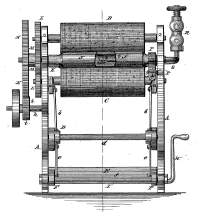 US patents from the 1870s show some later innovations in mangles. On the right is
Stephen Williams' "top view of my improved machine ... which shall be simple in construction
and effective in operation, applying the same pressure steadily to clothes whatever
may be their thickness".
US patents from the 1870s show some later innovations in mangles. On the right is
Stephen Williams' "top view of my improved machine ... which shall be simple in construction
and effective in operation, applying the same pressure steadily to clothes whatever
may be their thickness".
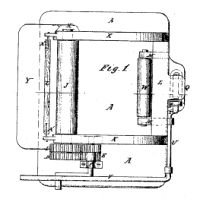 On the left is William and James Coutie's drawing of an "Improvement in ironing-machines"
with a gas-heated central roller.
On the left is William and James Coutie's drawing of an "Improvement in ironing-machines"
with a gas-heated central roller.
More on mangling history on the mangle boards page, and the history of ironing page.
Also see English box mangle photo
For more on laundry history and old washing methods go to
>>>> History of laundry and
>>>>
Laundry from 1800
 8 August 2007
8 August 2007
You may like our new sister site Home Things Past where you'll find articles about antiques, vintage kitchen stuff, crafts, and other things to do with home life in the past. There's space for comments and discussion too. Please do take a look and add your thoughts. (Comments don't appear instantly.)
For sources please refer to the books page, and/or the excerpts quoted on the pages of this website, and note that many links lead to museum sites. Feel free to ask if you're looking for a specific reference - feedback is always welcome anyway. Unfortunately, it's not possible to help you with queries about prices or valuation.


